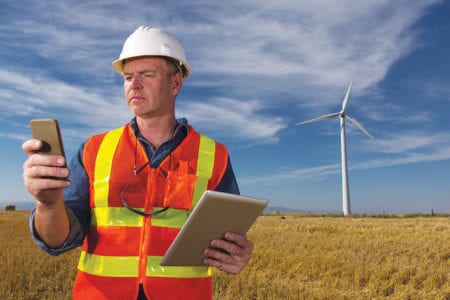Utility workers are the unsung heroes of the electricity system that keeps our lights on. They are most visible when dealing with power outages, as in the wake of the relentless parade of hurricanes this past fall or the recent winter storm Grayson “bombogenesis.” The critical work they perform during these events includes assessing damage to the grid and coordinating “mutual assistance” outage support. The utility work outside these outages — scheduled equipment maintenance, repairs, inspecting lines — is less visible, but no less important to the long-term reliability of the power system.
While utility workforce management systems have been in place for decades, they largely consist of multiple, separate applications that were built over time to address individual uses. In a way, utility workforce systems mirror the grid itself. They are not the result of a grand design but rather a patchwork reflecting a history more than a plan. Now these systems are on the cusp of an evolution driven by dual need and opportunity.
 The need for a holistic “digital worker” vision and architecture that covers the full range of utility worker tasks is driven by the imperative for utilities to not only realize ongoing improvements in safety, productivity and cost reduction but also to achieve better outcomes around reliability, customer satisfaction, and profitability — outcomes closely tied to service delivery. This imperative is tied to dynamics (distributed generation, aging grids) that challenge the ability of utilities to realize revenue and customer satisfaction goals. Meanwhile, a new generation of “digital natives” is entering the utility workforce, bringing their own expectations of digital capabilities and the need for collaboration with veteran colleagues.
The need for a holistic “digital worker” vision and architecture that covers the full range of utility worker tasks is driven by the imperative for utilities to not only realize ongoing improvements in safety, productivity and cost reduction but also to achieve better outcomes around reliability, customer satisfaction, and profitability — outcomes closely tied to service delivery. This imperative is tied to dynamics (distributed generation, aging grids) that challenge the ability of utilities to realize revenue and customer satisfaction goals. Meanwhile, a new generation of “digital natives” is entering the utility workforce, bringing their own expectations of digital capabilities and the need for collaboration with veteran colleagues.
The opportunity for utilities seeking a digital worker solution is that modern field service management is well positioned to support this evolution of utility workforce management. Cloud, mobility, and innovations such as IoT, artificial intelligence, drones, and wearables present enormous potential to digitally enable utility workers with the tools they need to deliver optimal service. In so doing, these workers will not merely realize ongoing improvements in productivity but will also support business goals for reliability, customer satisfaction, and profitability.
Field Service Management Solution
Executing a digital worker strategy begins with a leading field service management (FSM) solution. An end-to-end service delivery platform eliminates the inefficiencies associated with managing multiple applications. Cutting-edge mobile capabilities place asset and work data at the fingertips of utility workers, allow them to capture data through photos and videos, facilitate collaboration with team members, and enable them to work offline. In fact, our customers report multiple benefits from implementing our FSM solution, ranging from productivity to customer satisfaction and revenue growth.
Utility-Specific Applications
The second step of a digital worker strategy is to integrate this “horizontal” field service management capability with essential “vertical” utility-specific applications. Seamless integrations are core to the ServiceMax philosophy and central to realizing digital worker outcomes. Important integrations include mobile Geographic Information System (GIS) based work applications for damage assessment, mutual assistance, and inspections; Outage and Advanced Distribution Management (OMS, ADMS) Systems to manage outage related work; and Asset Performance Management (APM) systems to identify pending issues and trigger proactive service. Achieving these seamless integrations will ensure greater productivity, shorter and fewer outages, and higher customer satisfaction.
Incorporate Emerging Technologies
The third step of a digital worker strategy is to incorporate emerging technologies. Drones are the subject of growing utility attention and experimentation for their ability to automate inspections — reducing inspection time, increasing worker safety, and improving data accuracy. At ServiceMax, we are applying artificial intelligence to predict “time to service” and improve scheduling decisions. Wearables can enhance productivity, enhance data collection, and monitor worker safety. As they are deployed these innovations need to be integrated into a digital worker architecture.
To summarize: the digital worker is a solution suite that digitally enables utility workers to deliver flawless service. By optimizing service delivery, the digital worker helps utilities not only achieve significant improvements in productivity, safety, and cost reduction but also reach higher levels of reliability, customer satisfaction, and profitability.
GE will be showcasing its digital worker solutions in Lightning Talks and live demonstrations at DistribuTECH from January 23-25 in San Antonio, Texas.
For more information please visit https://www.servicemax.com/industries/power-utilities


Share this: